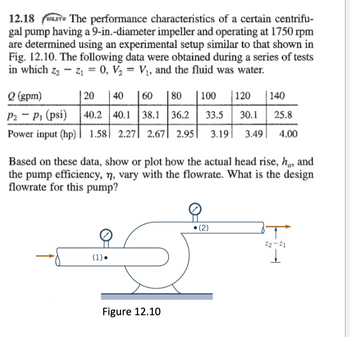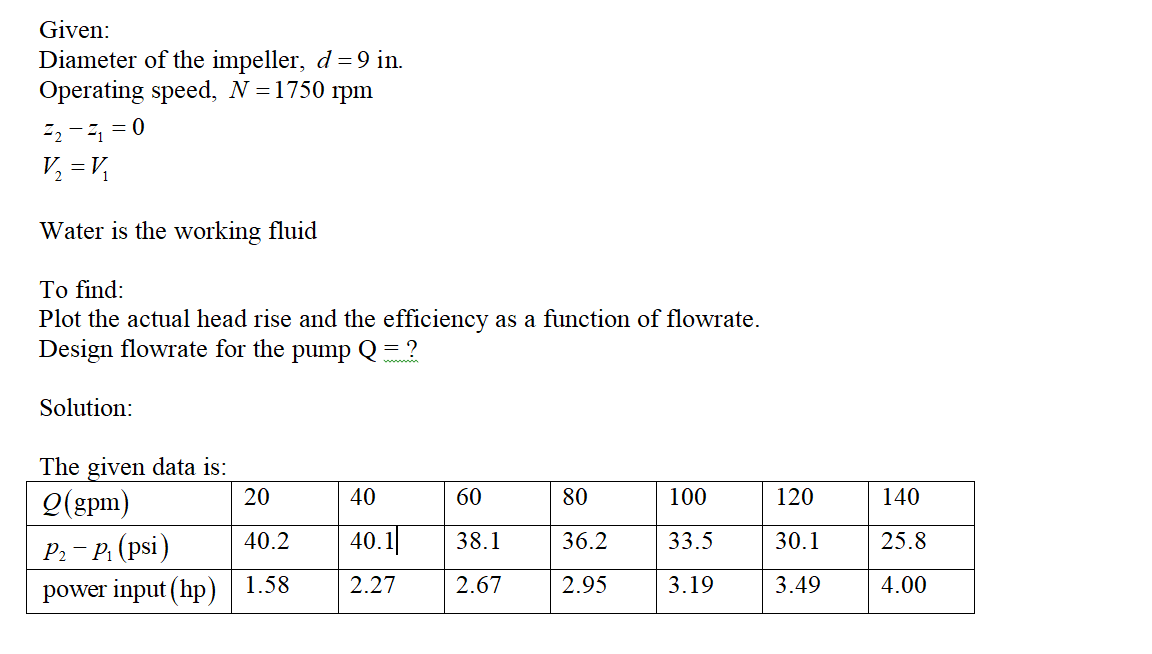
Elements Of Electromagnetics
7th Edition
ISBN: 9780190698614
Author: Sadiku, Matthew N. O.
Publisher: Oxford University Press
expand_more
expand_more
format_list_bulleted
Concept explainers
Question
Please list any assumptions and answer all parts

Transcribed Image Text:12.18 WEY The performance characteristics of a certain centrifu-
gal pump having a 9-in.-diameter impeller and operating at 1750 rpm
are determined using an experimental setup similar to that shown in
Fig. 12.10. The following data were obtained during a series of tests
in which z₂ Z₁ = 0, V₂ = V₁, and the fluid was water.
Q (gpm)
20 40 60 80 100 120 140
25.8
P2 - P₁ (psi) 40.2 40.1 38.1 36.2 33.5 30.1
Power input (hp) 1.58 2.27 2.67 2.95 3.19 3.49 4.00
Based on these data, show or plot how the actual head rise, ha, and
the pump efficiency, n, vary with the flowrate. What is the design
flowrate for this pump?
(1).
Figure 12.10
(2)
22-21
1
Expert Solution
arrow_forward
Step 1

Trending nowThis is a popular solution!
Step by stepSolved in 9 steps with 11 images

Knowledge Booster
Learn more about
Need a deep-dive on the concept behind this application? Look no further. Learn more about this topic, mechanical-engineering and related others by exploring similar questions and additional content below.Similar questions
- A hot water leak in one of the faucets of your apartment can be very wasteful. A continuous leak of one quart per hour (a "slow" leak) at 155 degrees°F causes a loss of 1.81 million Btu per year. Suppose your water is heated with electricity. a. How many pounds of coal delivered to your electric utility does this leak equate to if one pound of coal contains 12,000 Btu and the boiler combustion process and water distribution system have an overall efficiency of 28%? b. If a pound of coal produces 1.81 pounds of CO2 during the combustion process, how much extra carbon dioxide does the leaky faucet produce in a yeararrow_forwardSuppose you are considering buying a toyota prius, which starts ag 25,000$ and gegs 50 mpg. a similarly equipped Honda Accord will start ag $22,000 but will get 31 mpg. a) How many miles will it take the Prius to recoup the price difference? b.) Assuming you drive 1,000 miles per momth, how many years will it take you to recoup the price difference?arrow_forward
Recommended textbooks for you
 Elements Of ElectromagneticsMechanical EngineeringISBN:9780190698614Author:Sadiku, Matthew N. O.Publisher:Oxford University Press
Elements Of ElectromagneticsMechanical EngineeringISBN:9780190698614Author:Sadiku, Matthew N. O.Publisher:Oxford University Press Mechanics of Materials (10th Edition)Mechanical EngineeringISBN:9780134319650Author:Russell C. HibbelerPublisher:PEARSON
Mechanics of Materials (10th Edition)Mechanical EngineeringISBN:9780134319650Author:Russell C. HibbelerPublisher:PEARSON Thermodynamics: An Engineering ApproachMechanical EngineeringISBN:9781259822674Author:Yunus A. Cengel Dr., Michael A. BolesPublisher:McGraw-Hill Education
Thermodynamics: An Engineering ApproachMechanical EngineeringISBN:9781259822674Author:Yunus A. Cengel Dr., Michael A. BolesPublisher:McGraw-Hill Education Control Systems EngineeringMechanical EngineeringISBN:9781118170519Author:Norman S. NisePublisher:WILEY
Control Systems EngineeringMechanical EngineeringISBN:9781118170519Author:Norman S. NisePublisher:WILEY Mechanics of Materials (MindTap Course List)Mechanical EngineeringISBN:9781337093347Author:Barry J. Goodno, James M. GerePublisher:Cengage Learning
Mechanics of Materials (MindTap Course List)Mechanical EngineeringISBN:9781337093347Author:Barry J. Goodno, James M. GerePublisher:Cengage Learning Engineering Mechanics: StaticsMechanical EngineeringISBN:9781118807330Author:James L. Meriam, L. G. Kraige, J. N. BoltonPublisher:WILEY
Engineering Mechanics: StaticsMechanical EngineeringISBN:9781118807330Author:James L. Meriam, L. G. Kraige, J. N. BoltonPublisher:WILEY

Elements Of Electromagnetics
Mechanical Engineering
ISBN:9780190698614
Author:Sadiku, Matthew N. O.
Publisher:Oxford University Press

Mechanics of Materials (10th Edition)
Mechanical Engineering
ISBN:9780134319650
Author:Russell C. Hibbeler
Publisher:PEARSON

Thermodynamics: An Engineering Approach
Mechanical Engineering
ISBN:9781259822674
Author:Yunus A. Cengel Dr., Michael A. Boles
Publisher:McGraw-Hill Education

Control Systems Engineering
Mechanical Engineering
ISBN:9781118170519
Author:Norman S. Nise
Publisher:WILEY

Mechanics of Materials (MindTap Course List)
Mechanical Engineering
ISBN:9781337093347
Author:Barry J. Goodno, James M. Gere
Publisher:Cengage Learning

Engineering Mechanics: Statics
Mechanical Engineering
ISBN:9781118807330
Author:James L. Meriam, L. G. Kraige, J. N. Bolton
Publisher:WILEY